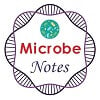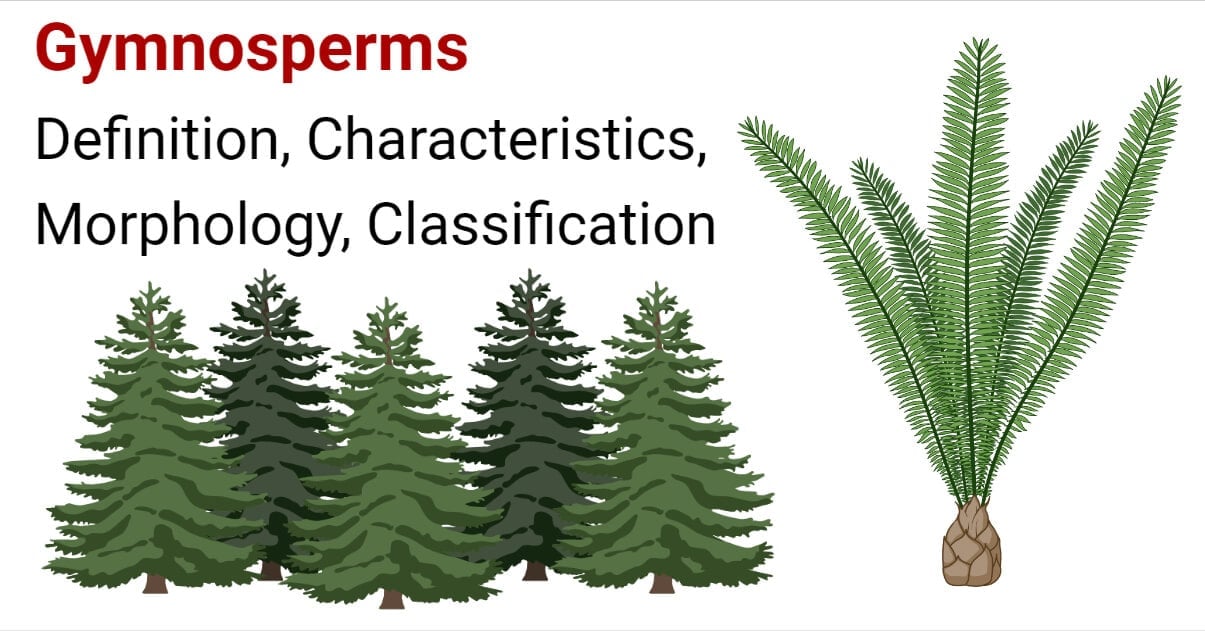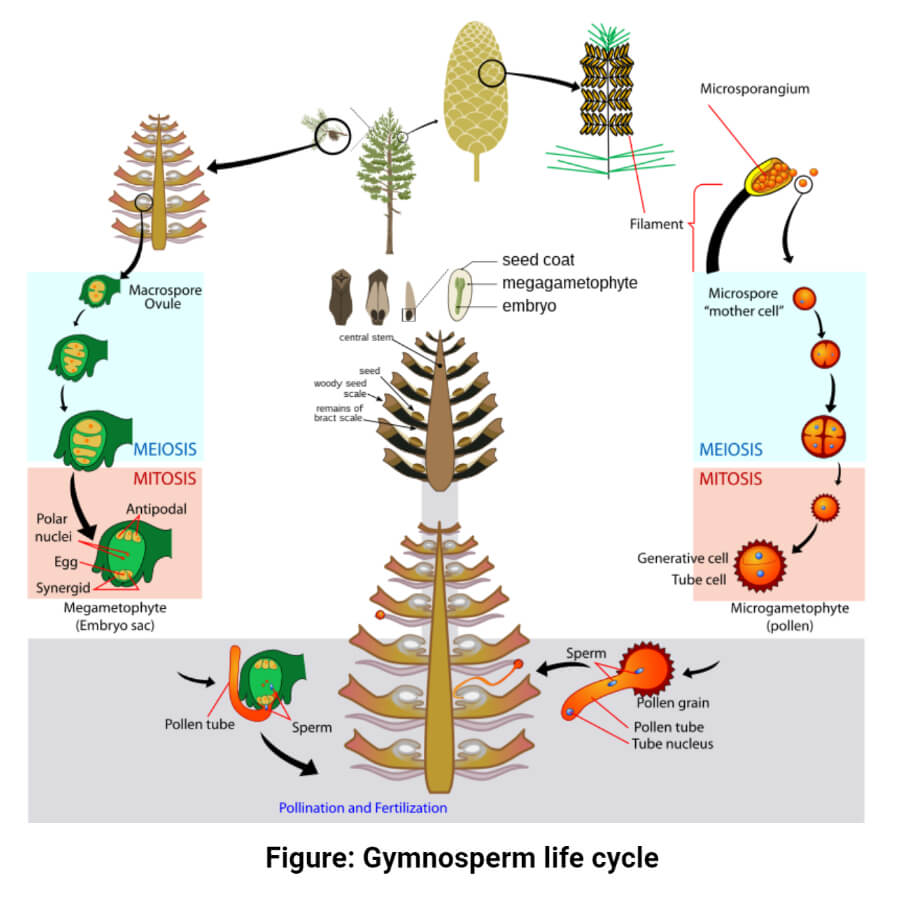Gymnosperms- Characteristics, Morphology, Classification, Uses

They produce seeds without fruits which means the ovules and the seeds that develop from these ovules are not enclosed in the fruit wall. It remains exposed before and after fertilization and before developing a seed.
The tallest tree-like sequoia and pines belong to gymnosperm plants.

In 300 B.C, Theophrastus used the word ‘gymnosperm’ in his book ‘Enquiry into plants’. This word originated from the Greek words ‘gymnos’ which means naked and ‘sperma’ means seed. Hence refer to ‘naked seeds.
Belonging to the kingdom ‘Plantae’ and sub-kingdom ‘Embryophyta’, there are 88 genera and about 1,000 species of gymnosperms distributed worldwide.
An abundant amount of gymnosperm is present in temperate forests and boreal forest biomes, they can able to tolerate moist or dry conditions.
Table of Contents
Interesting Science Videos
Characteristics of Gymnosperms
- The gymnosperm is a woody plant with seeds on the inner side of scale leaves that are usually arranged spirally to form cones or strobili but without flowers.
- Intermediated group between Cryptogams and Angiosperms.
- As gymnosperm lacks an ovary, it can’t produce fruit.
- They are perennial and show extreme xerophytic and terrestrial adaptation but never aquatic.
- In the stem and root, secondary growth occurs.
- Seeds present in a gymnosperm are naked that develop from ovules.
- Generally, gymnosperms are polyembryony, oospore forms embryo.
- Sexual reproduction is of oogamous type.
- They have formed male and female cones that bear microsporophylls on which microsporangia are born and megasporophylls on which megasporangia are born, respectively.
- Endosperm (of seeds) helps in the storage of food for the development of the plant.
- They are the dominant vegetation where snow is the source of water rather than water ( i.e, in cold regions of the world).
- The wind is a significant source of pollination.
- The gymnosperms are unisexual and may be monoecious or dioecious.
- Absence of double fertilization and triple fertilization.
- There is a lack of colorful sepals and petals in their reproductive organs.
- At the end of the suspensor, the embryo is fully developed.
Morphology and Anatomy of Gymnosperms
- These are usually medium to large trees with some shrub species present in them.
- One of the tallest tree species of a gymnosperm is Sequoia.
- The plant body is sporophytic, which is differentiated into roots, stem, and leaves.
- Gymnosperm bears tap root. They may have symbiotic relations with blue-green algae for coralloid roots of Cycas or with fungi for mycorrhizal roots in pines.
- The stems are branched(pines) and unbranched (Cycas), usually tail, straight, and covered with scaly bark.
- Two types of leaves are usually seen i.e., foliage leaves and scale leaves.
- Foliage leaves are green, simple, needle-shaped (pines), and large and pinnately compounds (cycas) help in photosynthesis.
- Scaly leaves are minute and deciduous, which helps in the protection of foliage leaf.
- Leaf lacks lateral veins. Therefore, the process of transfusion of tissue helps in the lateral conduction of food and nutrients.
- Sunken stomata covered with thick cuticles are present in leaves.
- Tissue is well differentiated.
- Vascular tissue present in gymnosperms is xylem and phloem. Xylem consists of tracheids and xylem parenchyma. The gymnosperm is softwood rather than hardwood due to the absence of vessels and wood fiber.
- The phloem of gymnosperm lacks companion cells and have albuminous cell.
- Vascular bundles in the stem are conjoint, open type, collateral, endrach, and radial type in the root.
- Fertilization and development take a long time in gymnosperms as it doesn’t produce fruits and flowers, and pine trees can have a lifespan of more than 100 years.
Classification of Gymnosperms
Due to the occurrence of gymnosperms in large groups (that may be both fossil or living forms), the classification of gymnosperms has become complicated to understand. A different worker classified gymnosperms into various classes.
Some of the important classifications are as follows:
In 1917 Counter and Chamerlain classified the gymnosperm into seven orders which are:
- Cycadofilicals
- Benenrttitales
- Cacadales
- Cordaitales
- Ginkoalea
- Coniferales
- Gnetales
In 1934, Chamberlain categorized gymnosperms into two classes which are further divided into different orders.
- Class: Cycadophyte (it is divided into three orders)
- Order: Cycadofilicales
- Order: Cycadeiodales
- Order: Cycadales
- Class: Coniferophyta (it is divided into four orders)
- Order: Cordaitales
- Order: Ginkgoales
- Order: Coniferales
- Order: Gnetales
In (1948), Gymnosperms were divided into three phyla by Arnold
- Phylum: Cycadophyta (it includes three orders)
- Order 1: Pteridosparmales
- Order 2: Cycadeoidales
- Order 3: Cycadales
- Phylum: Coniferophyta (it includes four orders)
- Order1: Cordaitales
- Order 2: Coniferales
- Order 3: Taxales
- Order 4: Ginkgoales
- Phylum: Chlamydospermophyta (it includes two orders)
- Order 1: Ephedrales
- Order 2: Gnetales
After that in 1961, Andrew classified gymnosperm into 6 divisions:
- Pteridospermatophyta
- Cycadohyta
- Coniferophyte
- Ginkgohyta
- Gnetophyta
- Gymnosperms of uncertain affinities
In 1965, K.R. Sporne in his book named “The Morphology of Gymnosperms” classified gymnosperm into 3 divisions based on Pilger and Melchior (1954) classification, these divisions were further classified into orders.
A. Cycadopsida
Order 1: Pteriodospermales (it includes 7 families)
- Lyginopteridaceae
- Medulosaceae
- calamopteridaceae
- Glossopteridaceae
- Peltospermaceae
- Corystospermaceae
- Caytoniaceae
Order 2: Bennettitales (it includes 3 families)
- Williamsoniaceae
- Wielandiellaceae
- Cycadeoideaceae
Order 3: Pnetoxylaes (only one family)
Order 4: Cycadales(it includes 2 families)
- Cycadaceae
- Nilssoniaceae
B. Coniferopsida
Order 1: Cordaitales (it includes 3 families)
- Ertophytaceae
- Cordaitaceae
- Poroxylaceae
Order 2: Coniferales (it includes 9 families)
- Lebachiaceae
- Vitziaceae
- Palissyaceae
- Pinaceae
- Taxodiaceae
- Cupressaceae
- Podocarpaceae
- Cephalotaxaceae
- Araucariaceae
Order3: Taxales (only one family: Taxaceae)
Order 4: Ginkgoales (contains 2 families)
- Trichoptyaceae
- Ginkgoaceae
C. Gnetopsida
Order 1: Gnetales (includes 3 families)
- Gnetaceae
- Welwitschiaceae
- Ephedraceae
In the modern classification, gymnosperms are divided into four main orders.
A. Cyadales
- They are dioecious (meaning: separate male or female).
- Cyadales group of gymnosperms are found in tropical areas that originally originated in the Triassic period.
- Cyadales are represented by both living members and fossils.
- They are woody, wood is monoxylic.
- Leaves are pinnately compound. Young leaves with Circinate Ptyxix.
- Megasporophyll does not form female cones, Cyadales cones are large with many fertile leaves. E.g. sporophylls arranged into cones.
- Male gamete is motile.
- Cycadales are commonly called pandas of the plant kingdom.
- They are used as ornamental plants because their shape is beautiful.
- Examples: Cycas, Zamia.
B. Ginkgoales
- Ginkgoales are represented by living members.
- Wood is pycnoxylic.
- Sperm are motile and contains spiral bands of flagella and multicillated.
- Dichotomous venation is generally present in the leaves.
- Ginkgoales contain only one extant species which is Ginkgo biloba.
C. Coniferales
- They have a sporophytic plant body and the sporophytes are richly branched trees or shrubs.
- Vessels are absent.
- Wood is monoxylic.
- Schizogenous canals present that form resin.
- Male gametes are non-motile and multicliated and male and female cones are present in Coniferales.
- Example: Sequoia, pinus, Thuya, Taxus, Aravcaria, etc.
D. Gnetales
- They form connecting link between angiosperm and gymnosperms.
- Wood is pycnoxylic.
- Shrubs and small trees belong to Gnetales.
- The reproductive structure of Gnetales orders plants is almost similar to flowering plants.
- Embryo with 2 cotyledons.
- The ovule is nacked but bitegmic.
- Examples: Gnetum, Ephedra, Welwischia.
Evolution of Gymnosperms
- Gymnosperms originated during the late paleozoic era and evolved from the late Paleozoic to the Mesozoic era (about 390 million years ago).
- Gymnosperms are of monophyletic origin and are a group of those plants which are known as Progymnosperms (woody spore-bearing plants but not producing seeds).
- Progymnosperms gave rise to Aneurophytes (producing identical spores) that give rise to Pteriodosperms (produced seed) and Archaeptridales.
- Petriodosperms are found in the late Devonian period, the earliest seed plant known is the fossil plant Elkinsia polymorpha. They developed structures called cupules to enclose and protect the ovule.
- Archaepteridales develop into the Cordaitales and Voltziaes, Cordaitales are trees and shrubs that develop in the Carboniferous and Permian periods. They contain ovulate cones and cambium tissue.
- Phylum Ginkgophyte evolved from Cordaitales, which persist to the present day.
- Gingko biloba is the first gymnosperms to appear during the lower Jurassic period.
- Bennettitales is a group of pteridosperm which represent the present Cycades.
Life Cycle of Gymnosperms
The life cycle of gymnosperms follows alternation of generation, which means plants alternate between sporophyte (spore-bearing phase) and gametophyte (gamete-bearing phase) generation.

In a gametophyte phase, gametes are produced by sexual reproduction, and in a sporophyte phase, spores are produced by asexual reproduction.
Sporophyte generation
- The sporophyte generation represents adult (including roots, stems, cones, and leaves), diploid (contain two sets of chromosomes), and photosynthetic plants that produce the male and female cones.
- Cones developed either in the same plant or in different plants. In the case of male and female cones present in the same plant, the female cones or strobili are produced in the upper part of the branches, and male cones are present in the lower portion.
- Male strobili of gymnosperms produced haploid microspores, and female cones produced megaspores by the process of meiosis.
Gametophyte generation
- After microspore and megaspores undergo meiosis, haploid microgametophyte (male gamete) and haloid female gametophyte (megagametophyte) are produced.
- These gametophytes have a short life span and are developed into sperm cells by male gametophytes and egg cells by female gametophytes.
- Gametophytes take a nutrient from sporophyte, and the female gamete remains attached to it until they undergo the fertilization process and seeds disperse.
- Male and female gamete unite at pollination to produce a zygote (diploid). Pollination occurs due to winds, natural agents, animals, or insects.
- New diploid sporophytes produce when zygote mature.
- The newly formed sporophyte is enclosed in a seed (in the form of an embryo), seeds are separated and dispersed via wind and rain when favorable conditions are reached.
- Seeds are spreading to different places, saprophyte germinate and develop into a new adult, diploid plant and again begin the same process.
Reproduction of Gymnosperms
- All gymnosperms are heterosporous and produce microspores and megaspores.
- Microspores are produced in the pollen cone and become pollen grains, and megaspores produce in archegonia are present in ovulating cones.
- Some species have both male and female cones in the same plants (e.g. Pinus), while male and female cones are found in different plants seen in other plants (e.g. Cycas).
- Male cones: male cones bear microsporophylls, which have the microsporangia that form the microspores i.e. haploid. From these microspores, male gamete developed known as pollen grains, and some microspores degenerate.
- Female cones: female cones have megasporophylls, that bear the ovules containing the megasporangium, which produce the haploid megaspores and a mother megaspore.
- A mother megaspore undergoes meiotic division to produce four megaspores; from these megaspores, one becomes mature and develops into a multicellular female gametophyte.
- Female cones are larger than male cones.
- For pollination, male and female gametes must be in contact with each other; this type of union occurs by wind and animal or insect.
- When pollen grains and female ovules are in contact with each other, fertilization of gymnosperms occurs.
- After fertilization zygote is formed within the gymnosperm seed and develops a new sporophyte.
Applications and Uses of Gymnosperms
- Some gymnosperms are used as a food such as various species of Cycas leaves are used as a vegetable, the famous starch “sogo” is obtained from seed and stem of Cycas used as a food.
- An abundant amount of nitrogen is found in the leaves of Cycas, and these leaves are used as green manure for rice and sweet potato.
- Gingko biloba leaf is used as medicine for the treatment of cerebral insufficiency.
- Some gymnosperms are used as ornamental for décor gardens and houses.
- Many gymnosperm plants are woody plants that are used for manufacturing furniture, aircraft, and household materials.
- Resin is obtained from gymnosperms used in the paints and liqueurs industry and also used as a medicine.
- Some are used in the pharmaceutical industry, like juice extracted from Cycas used to prevent blood vomiting, Ephedrine extracted from Ephedra used for the treatment of cold, cough, asthma, and other illness.
- A gum extracted from Cycas is used for the treatment of snake bites as an antidote.
- In the leather industry, Conifer bark is mainly used.
- Other uses of gymnosperm include gum, soap, nail paints, varnish, and perfume.
- Gymnosperms are the source of fuel.
Examples of Gymnosperms
References
- Chamberlain, C.J. Gymnosperms Structure and Evolution. CBS Publishers and Distributors, Darya Ganj, New Delhi-110002 (India).
- Keshari, A.K., Ghimire,K.R., Mishra, B.S. and Adhikari, K.K.(2018). A Textbook of Higher Secondary Biology, XII. Vidhyarthi Pustak Bhander, Kamalpokhari/Bhotahiti, Kathmandu, Nepal.
- https://www.uou.ac.in/lecturenotes/science/MSCBOT-17/Gymnosperm%20(BOT-503)%20by%20Dr.%20Prabha%20Dhondiyal-converted%20(1).pdf
- https://www.britannica.com/plant/gymnosperm.
- https://byjus.com/biology/gymnosperms/.
- https://www.thoughtco.com/what-are-gymnosperms-4164250.
- https://openstax.org/books/concepts-biology/pages/14-3-seed-plants-gymnosperms.
- https://bio.libretexts.org/Bookshelves/Botany/Botany_in_Hawaii_(Daniela_Dutra_Elliott_and_Paula_Mejia_Velasquez)/08%3A_Gymnosperms/8.01%3A_Gymnosperms.
- https://www.embibe.com/exams/gymnosperms/.
- https://courses.lumenlearning.com/wmbiology2/chapter/gymnosperms/#:~:text=All%20gymnosperms%20are%20heterosporous.,homes%E2%80%9D%20or%20unisexual)%20plants.
- https://bio.libretexts.org/Courses/Lumen_Learning/Book_Biology_for_Non_Majors_II_(Lumen)/09%3A_Module_6-_Plant_Diversity/9.09%3A_Gymnosperms.
- https://study.com/academy/lesson/gymnosperms-characteristics-definition-types.
- https://biologywise.com/life-cycle-of-gymnosperms.
- https://bio.libretexts.org/Bookshelves/Introductory_and_General_Biology/Book%3A_General_Biology_(Boundless)/26%3A_Seed_Plants/26.01%3A_Evolution_of_Seed_Plants/26.1B%3A_Evolution_of_Gymnosperms.
- https://allusesof.com/plant/uses-of-gymnosperms.
- https://plantlet.org/gymnosperm.
About Author
Babita Sharma did her Master's degree in Medical Microbiology from the Central Department of Microbiology, Tribhuvan University, Kathmandu, Nepal. She had worked as a quality control officer at Kasturi Pharmaceutical Pvt Ltd. She is interested in Virology, Molecular biology, and pharmaceutical microbiology.
1 thought on “Gymnosperms- Characteristics, Morphology, Classification, Uses”
Abdulrahman mukhtar
Thanks for the answers Reply
Leave a Comment Cancel reply
Topics / Categories

- Agricultural Microbiology (13)
- Bacteriology (124)
- Basic Microbiology (61)
- Biochemical Test (114)
- Biochemistry (165)
- Bioinformatics (23)
- Biology (209)
- Biotechnology (31)
- Cell Biology (107)
- Culture Media (67)
- Difference Between (89)
- Diseases (32)
- Environmental Microbiology (7)
- Epidemiology (23)
- Food Microbiology (51)
- Genetics (79)
- Human Anatomy and Physiology (75)
- Immunology (115)
- Instrumentation (64)
- Microscopy (27)
- Molecular Biology (78)
- Mycology (33)
- Parasitology (26)
- Pharmacology (14)
- Phycology (2)
- Protocols (9)
- Research Methodology (20)
- Staining (29)
- Syllabus (18)
- Virology (50)
- Mycorrhiza: Definition, Types and Significances
- Marine Ecosystem and its Abiotic and Biotic Components
- Homeostasis: Definition, Types, Examples, Applications
- Neutrophils: Definition, Structure, Count, Range, Functions
- Whole Transcriptome Sequencing (WTS) / Total RNA-Seq





